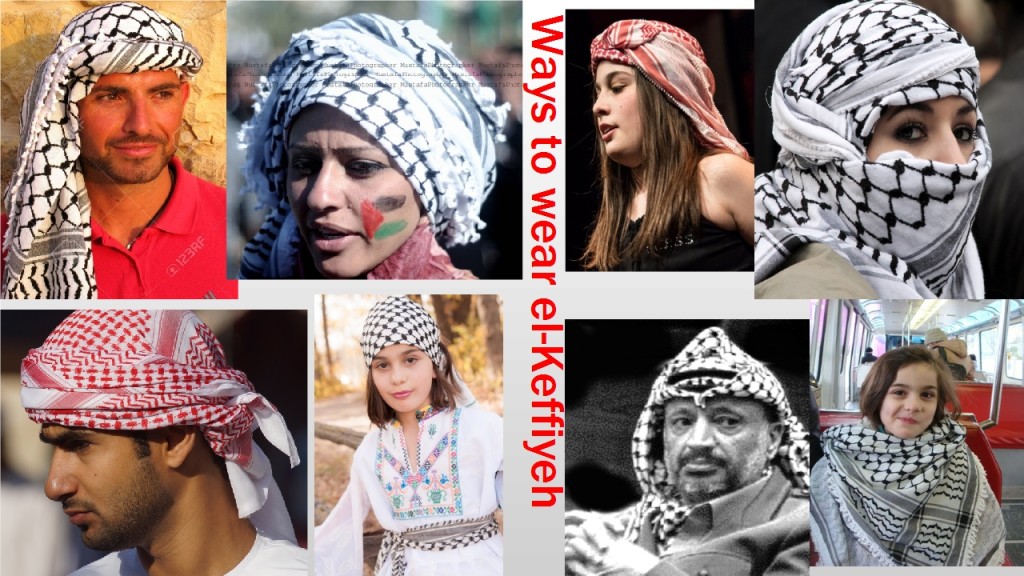![Winnipeg, June 11, 2016: Human rights activist Rana Abdulla spoke at the Winnipeg Walk for Peace on the history and significance of a traditional Palestinian scarf knows as the keffiyeh. Photo: Paul S. Graham]()
Winnipeg, June 11, 2016: Human rights activist Rana Abdulla spoke at the Winnipeg Walk for Peace on the history and significance of a traditional Palestinian scarf knows as the keffiyeh. Photo: Paul S. Graham
by Rana Abdulla
We will talk today about the significance of the traditional scarf (keffiyeh as a show of solidarity), the controversy around it, its emergence in fashion and cultural appropriation, and how to wear it.
The keffiyeh is one of Palestine’s most iconic symbols. It is incredibly important; it is Palestinians’ daily reminder of the repression they face on a daily basis and its cultural appropriation. The keffiyeh is the hope that’s been passed down with every worn-out keffiyeh, generation after generation. Keffiyeh reminds all Palestinians of their right to resist. Keffiyeh reminds all Palestinians of their right to live in their land without any occupation. It is important, therefore, that non-Arabs, wear it only out of respect for the wishes of Palestinians themselves.
A statement alright, but not fashion
![slide5]() In late 2000, the keffiyeh became political when the fashion world collided with the political world. All of a sudden, the traditional Arabic head dress became a fashion statement. In 2007, it even made it to the major couture houses including Balenciaga and stores across the US including Urban Outfitters began selling the keffiyeh as a fashion symbol scarf.
In late 2000, the keffiyeh became political when the fashion world collided with the political world. All of a sudden, the traditional Arabic head dress became a fashion statement. In 2007, it even made it to the major couture houses including Balenciaga and stores across the US including Urban Outfitters began selling the keffiyeh as a fashion symbol scarf.
A few years ago, a new visitor took over the streets & fashion boutiques across the world. Imagine my surprise when I saw this visitor, the keffiyeh in Rideau Mall in Ottawa, learning later that it had been sold at Urban Outfitters under the name ”anti-war scarf.” Both of my grandfathers had worn this article of clothing, held in place on their heads by a black rope – the ‘Aqal.’
This fashion accessory wasn’t new or invented in the studio of any designer. In fact, it had been the accessory of choice for Arab men for many, many years. The keffiyeh was not born on the shoulders of hipsters and Urban Outfitters patrons. Instead its common use for so long had been to shield Arab men from the sun. Slowly it transformed from an item of utility to a symbol of Palestinian resistance and now you will be hard pressed not to find a pink version of it in your teenage sister’s closet courtesy of Forever21.
Urban Outfitters stopped selling keffiyah after “a pro-Israel activist… complained about the items”, and the store also issued a statement that “the company had not intended ‘to imply any sympathy for or support of terrorists’ in selling the keffiyehs and was pulling them”. Caroline Glick, deputy editor of the Jerusalem Post, equates the Palestinian keffiyeh with the fascist wearing of brown shirts.
![slide6]() Dunkin Donuts
Dunkin Donuts
The keffiyeh has become a symbol steeped in misconceptions over the past years. Some of you may recall the Dunkin’ Donuts/ Rachael Ray “scandal” of 2008, when the popular donut shop pulled an online commercial featuring Ray because she wore a black and white scarf resembling the keffiyeh. Right-wing blogger Michelle Malkin discussed the issue in her blog, and on May 28 commented: “Anti-American fashion designers abroad and at home have mainstreamed and adapted the scarves as generic pro-Palestinian jihad or anti-war statements. Yet many folks out there remain completely oblivious to the apparel’s violent symbolism and anti-Israel overtones.” This reflect the sentiments which many expect I should face. Dunkin Donut did what is actually offensive for no good reason. They labelled a scarf for terrorists and deemed all Palestinians by extension as terrorist .
Israeli Scarf
![slide8]() Not much later, an Israeli scarf version of the keffiyeh appeared, much at the dismay of the Palestinians. Those who believe they understand the true symbolism of the keffiyeh have branded it as “anti-Semitic” and a “political statement supportive of Islamic terrorism against Israel.” Little do they know that the only democracy in the Middle East uses every means of psychological warfare as a weapon to disrupt history and culture, sadly not only affecting the world but the occupied Palestinians, too!
Not much later, an Israeli scarf version of the keffiyeh appeared, much at the dismay of the Palestinians. Those who believe they understand the true symbolism of the keffiyeh have branded it as “anti-Semitic” and a “political statement supportive of Islamic terrorism against Israel.” Little do they know that the only democracy in the Middle East uses every means of psychological warfare as a weapon to disrupt history and culture, sadly not only affecting the world but the occupied Palestinians, too!
What’s the big deal?
The true reason 90% of the world wearing this “Arab farmer’s uniform” is as a solidarity statement. The keffiyeh symbolizes the Palestinian’s resistance, it is also a cultural garment, in a land where culture became resistance.
It means something different to everyone, even in Palestine. The more correct answer is that this universal “Arabic style” scarf symbolizes your pride in your heritage, and willingness to fight to keep it alive. It’s resistance on the individual level, since no two people define it the same way.
By separating the keffiyeh from its symbolic relationship to the Palestinian national identity, Israeli and the Western World have just disempowered Palestinian nation building.
![slide16]() The black and white keffiyeh as we use it today is merely a traditional Arab head covering. Its importance to the cause came about when it became Yassir Arafat’s trademark. With his being the face of the PLO, the once meaningless head scarf meant to keep the sun out of the eyes and the dirt out of the face was given a meaning.
The black and white keffiyeh as we use it today is merely a traditional Arab head covering. Its importance to the cause came about when it became Yassir Arafat’s trademark. With his being the face of the PLO, the once meaningless head scarf meant to keep the sun out of the eyes and the dirt out of the face was given a meaning.
Perhaps the deeper question is, what does it mean to be a symbol of Palestine? A symbol of Palestine is something much greater, something much deeper than modern Islamic extremism. To represent Palestine is to represent thousands of years of rich history. The keffiyeh ties today to the past, to a deep tradition that is not religious. The keffiyeh has come to represent strength and solidarity, and courage in the face of adversity.
Yes, the keffiyeh is in many ways a symbol of Palestine, but this does not make it a proponent of violence or bloodshed. The keffiyeh is a symbol of freedom, of hope, of a people’s fight against repression.
Why I wear it
I wear the keffiyeh not because it’s a great fashion accessory or because it’s totally in style. I wear it to remind myself and those who recognize it that there is still injustice in the world, and also because I know peace is possible. For me, the keffiyeh is also much more personal than that. The keffiyeh represents my family in Palestine and I wear the keffiyeh for them in support of their struggle.
The history of this scarf was worn by all Arab people, goes back 1000s of years, has little to do with violence; it’s just a headscarf. We wear it now in a sign of solidarity with the Palestinians against colonial rule and the oppressed people in the Arab world and it is not an association with terrorism
Originality
While it is impossible to deny the popularity of the keffiyeh in the world of fashion, it is always important to understand the history behind symbols. The keffiyeh cannot be separated from its rich history. Even as a young girl I attributed the keffiyeh to the dignity of my grandfathers.
Not to confuse authenticity with novelty, there is a difference between fast fashion costume jewelry and your grandmother’s locket.
Whether placed on the heads of older men, tied around the necks of hipsters, or draped across the shoulders of activists it is always important to understand the meaning of the keffiyeh and why it cannot be just a scarf.
History
Again, the keffiyeh has a long history in the Arab World, it has come to represent Palestinian solidarity specifically. A keffiyeh is an indigenous headpiece of all Semitic people, traditionally worn by men. Black and white keffiyeh are worn by Palestinian men of any rank. Farmers traditionally wore it to keep out the heavy dust and sand and for farmers to keep their heads cool as they plowed in their fields.
The checkered pattern was said to refer to many things including a fishing net, a honeycomb, the joining of hands, or the marks of dirt and sweat wiped off a worker’s brow.
During the Palestinian Revolt in the 1930s, Palestinians wore the keffiyeh as a symbol of nationalism and resistance against increasing British rule and Zionist settler-colonialism. It became a symbol of Palestinian nationalism during that time.
So, before the 1930s, the keffiyeh had been commonly used by men like my grandfathers in the villages to protect from the sun while in the fields. Men in the city had very little use for the keffiyeh until a fateful mixing of resistance and unity. In order to protect their fellow Palestinians, townsmen began to wear the keffiyeh in unity with the villagers and peasants. This act of solidarity made it difficult for the British to find their fellow Palestinians.
Its prominence increased during the 1960s with the beginning of the Palestinian resistance movement. It became tied to Palestinian national identity with the rise of the PLO under the leadership of Yasser Arafat who adopted it. Certain colored keffiyehs would be associated with different political parties.
The keffiyeh became became gender-neutral and continues until this day to be our traditional symbol of resistance, so, our Palestine worn around our necks. It is a symbol of solidarity of the Palestinian cause especially in the Diaspora. Outside of the Middle East and North Africa, the keffiyeh first gained popularity among activists supporting the Palestinians in the conflict with Israel and is an icon of Palestinian solidarity.
Palestinian Figures
The black-and-white fishnet pattern keffiyeh became Arafat’s iconic symbol and he was rarely seen without it. Arafat would wear his keffiyeh in a semi-traditional way, wrapped around his head via an Agal. He had made it his personal trademark to drape the scarf over his right shoulder only, arranging it in the rough shape of a triangle, to resemble the outlines of the map of Palestine. This way of wearing the keffiyeh became a symbol of Arafat as a person and political leader, and it has not been imitated by other Palestinian leaders.
![slide 17]() Another Palestinian figure associated with the keffiyeh is Leila Khaled, a female member of the armed wing of the Popular Front for the Liberation of Palestine. Several photographs of Khaled circulated in the Western newspapers included Khaled wearing a keffiyeh in the style of a Muslim woman’s hijab, wrapped around the head and shoulders. This was unusual, as the keffiyeh is associated with Arab masculinity, and many believe this to be something of a fashion statement by Khaled, denoting her equality with men in the Palestinian armed struggle.
Another Palestinian figure associated with the keffiyeh is Leila Khaled, a female member of the armed wing of the Popular Front for the Liberation of Palestine. Several photographs of Khaled circulated in the Western newspapers included Khaled wearing a keffiyeh in the style of a Muslim woman’s hijab, wrapped around the head and shoulders. This was unusual, as the keffiyeh is associated with Arab masculinity, and many believe this to be something of a fashion statement by Khaled, denoting her equality with men in the Palestinian armed struggle.
Red or White
The first red and white keffiyehs originated in Manchester. They were being ordered for Jordanian army. They wanted red and white as they wanted their army to be distinctive & distinguishable.
People started liking it. So it was then not only being used for military or army purpose but for general purpose as a whole.
They took a new political importance in 1970s battle between Palestinians and Jordan. The author of “War of Words” Yasser Suleiman wrote that the fight between the red and white Jordanian and black & white Palestinian gained popularity after some Jordanian university students wore the red and white keffiyehs as their Jordanian identity and as anti-Palestinian identifications.
![Two old man with keffiyeh in front of castle Krak. Al Karak also known as Kerak, is a city in Jordan known for its crusader castle, the Kerak Castle. The castle is one of the three largest castles in the region, the other two being in Syria. Karak is the capital city of the Karak Governorate.]()
![slide19a]() The colors of the stitching in a keffiyeh are also vaguely associated with Palestinians’ political sympathies. Traditional black and white keffiyehs became associated with Fatah. Later, red and white keffiyehs were adopted by Palestinian Marxists, such as the PFLP.
The colors of the stitching in a keffiyeh are also vaguely associated with Palestinians’ political sympathies. Traditional black and white keffiyehs became associated with Fatah. Later, red and white keffiyehs were adopted by Palestinian Marxists, such as the PFLP.
Black-and white keffiyeh has been sometimes referred to as the “unofficial” flag of Palestine. Red and white keffiyehs origin can be traced back to military and armed forces headscarves, instead of just political sentiments & affiliations. Countries like Iraq, Saudi Arab and Syria also adopted red and white keffiyehs.
Our Ignorance
I vividly remember walking in Kuwait on the 15th of May (Al Nakba commemoration day) earlier in the 70’s, wearing a keffiyeh. Almost everyone that walked past us would smirk and say sarcastically, “Oh, she wants to liberate Palestine!”
The lack of realization of lives under occupation has made the world careless about what el kuffiyeh means to the world. This has made it an easy target for our keffiyeh to be worn as a fashion accessory!
Many, if not all wearers of this garb for fashion reasons are completely ignorant of a keffiyeh’s true meaning.
Of course, “Israel” has even started to rebrand el keffiyeh as its own, despite referring to it once upon a time as “terrorist” symbolism. Ironically, it fits with “Israel” under that account.
Cultural Appropriation
This is generally defined as: “The taking from a culture that is not one’s own – of intellectual property, cultural expression or artifacts, history and ways of knowledge”
And as Jonathan Hart explains why cultural appropriation is destructive: (1) members of one cultural group misrepresent other cultural group and thereby harm them. (2) when a majority culture misrepresents a minority culture, it limits the audience the minority can reach in representing itself. (3) when other cultural groups misrepresent cultures, they steal the religious and cultural meaning of those cultures’ stories and pictures.
Western fashion often comes finding about the new and unexplored. Unfortunately, the new and explored are actually culturally appropriated.
Non-Authentic Keffiyeh
The western world culturally appropriated the Palestinian national symbol. And in the fall of 2007 collection, Balenciaga released the line of clothing that took its inspiration from ethnic line of fabric and one of those fabrics was the Palestinian keffiyeh, not too much later, you would often see celebrities wear them and soon became an accessory. Balenciaga’s version of the keffiyeh was toted the ”must-have accessory” of that year.
Before Urban Outfitters, keffiyehs were hard to find, but one of the places you were always sure to find authentic keffiyehs was the Hirbawi factory, the only keffiyeh factory in Palestine, run by the Hirbawi family for their livelihood. Ironically, Balenciaga certainly made more money off of their keffiyeh than the Hirbawi factory.
Hirbawi Textile Factory
![slide24]() For 50 years, Herbawi had been the only keffiyehs manufacturer, using 100% cotton. Today, this symbol of Palestinian identity is now largely imported from China. Herbawi Factory has 16 machines. In 1990, all 16 machines were functioning, making 750 keffiyehs per day. By 2010, only 2 machines were used, making a mere 300 keffiyehs per week.
For 50 years, Herbawi had been the only keffiyehs manufacturer, using 100% cotton. Today, this symbol of Palestinian identity is now largely imported from China. Herbawi Factory has 16 machines. In 1990, all 16 machines were functioning, making 750 keffiyehs per day. By 2010, only 2 machines were used, making a mere 300 keffiyehs per week.
Herbawi doesn’t object to the modern commercialism of the keffiyeh, but he stated that “the keffiyeh is a tradition of Palestine and it should be made in Palestine. We should be the ones making it.”
The factory is “the only and the last” to produce the keffiyeh, thanks to a true Palestinian from Hebron, who started a business to ensure that our symbol of resistance, our culture, would continue to exist throughout many years to come. Hopefully the old will die but only after enlightening the young, and may we continue to literally wear our pride around our necks as Palestinians. May we continue to defy the occupiers, who believe that mutating our culture erases us from existence.
From China
![slide 25]() When the keffiyeh transformed to a fashion statement, ironically Chinese manufacturers instead of Palestinians profited from its sales. Although it is a bit clear that the Western world took the keffiyeh from Palestinian culture, the Israeli appropriation of the keffiyeh is more complicated.
When the keffiyeh transformed to a fashion statement, ironically Chinese manufacturers instead of Palestinians profited from its sales. Although it is a bit clear that the Western world took the keffiyeh from Palestinian culture, the Israeli appropriation of the keffiyeh is more complicated.
National Identity Recreated
The State of Israel has a policy of looking back at the traditional Middle Eastern culture as the form of their national identify, and this makes them see they have more claim to the keffiyeh than western fashion’ Since the Israeli State literally has to create its national identity and happy opportunity to pick and choose from Middle Eastern culture to incorporate in its national narrative, a new version of the scarf appeared, much at the dismay of Palestinians across the world.
One of the most ways in which Israeli state did this was through the creation of Israeli National costume. For example, in 1950, the government held a contest to come up with a national dress design and designers took an inspiration from Arab dress like the Abbayah. This comes right after they depopulated all Palestinian villages two years prior.
Keffiyeh with Star of David
It isn’t too far from a stretch to reinvent the keffiyeh as Israeli with distinct with star of David. Israeli society has tried to steal Palestinian culture for a long time now, just look at their attempt to steal food culture.
They don’t only appropriate our culture, Lebanese producers have had issues with traditionally Lebanese dishes. One producer reacted how bizarrely they claim our food its their own said: not enough they steal our land, they steal our civilisation, our culture and our cuisine. This attitude marries what the Palestinians have towards the keffiyeh.
It’s like the white settlers of the Americas, who took in Natives mythology and tried to make it part of their culture.
Both are instances of a nervous settler-colonial population with thin roots in the region who try to cover that fact up with blatant theft of the native culture. This is sad and disturbing – but entirely expected.
Disempowerment of national identity
We denounce cultural appropriation of the keffiyeh, defending it as a symbol of Palestinian solidarity, in Shadia Mansour’s song, “al-Kūfīyah ʻArabīyah (‘The keffiyeh is Arab’).“ She performs wearing a Palestinian thawb and proclaims in her song: “This is how we wear the keffiyeh/The Arab keffiyeh” and “I’m like the keffiyeh/However you rock me/Wherever you leave me/I stay true to my origins/Palestinian.”
Onstage in New York, she introduced the song by saying, “You can take my falafel and hummus, but don’t touch my keffiyeh.”
Symbols have meaning, regardless of what one may wish. When the ethnic cleansing of millions of Palestinians throughout the years of occupation imposed by the only democracy in the Middle East, “Israel”, and the inhumane actions of mass killings and rape of land are enough to make your blood boil, one more thing can be added to multiply the amount of steam coming out of your ears: the cleansing of Palestinian culture.
al-Kūfīyah ʻArabīyah – The keffiyeh is Arab
No matter how they design it, no matter how they change its color, the keffiyeh is Arab, and it will stay Arab. The keffiyeh is a headdress that has been worn by people in the Arab Peninsula for centuries. However, the keffiyeh and this pattern in particular became symbolic of Palestinian resistance in the 50’s/60’s, embraced by Yasser Arafat.
The scarf, they want it
Our intellect, they want it
Our dignity, they want it
Everything that’s ours, they want it
We won’t be silent, we won’t allow it
How to wear it
![slide33]()
While Western protesters wear differing styles and shades of keffiyeh, the most prominent is the black-and-white keffiyeh. This is typically worn around the neck like a neckherchief, simply knotted in the front with the fabric allowed to drape over the back. Other popular styles include rectangular-shaped scarves with the basic black-and-white pattern in the body, with the ends knitted in the form of the Palestinian flag.
Since the Al-Aqsa Intifada, these rectangular scarves have increasingly appeared with a combination of the Palestinian flag and Al-Aqsa Mosque printed on the ends of the fabric.
How to wrap a Keffiyeh
Step 1: Fold it in half
Fold the keffiyeh in half diagonally so you get a big triangle then put it over your head.
Step 2: Pinch, wrap and tuck
Pinch the fabric over your ear and wrap that side in front of your face then around your head and tuck it into itself.
Step 3: The other side
Same thing as before, but instead of going in front of your face go under your chin.
Step 4: Enjoy!
The brilliant thing about the head wrap is the convertible nature of the face section.
This article is the text of a speech by Rana Abdulla at the 35th annual Winnipeg Walk for Peace on Sunday, June 11, 2016. You can watch her speech and those of the other speakers in this video.
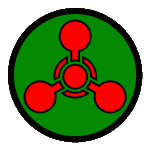 UNITED NATIONS, Sep 10 2013 (IPS) – If Syria eventually agrees to relinquish its stockpile of chemical arms under the 1993 international Chemical Weapons Convention (CWC), what of the six other countries that have either shown reluctance or refused to join the treaty?
UNITED NATIONS, Sep 10 2013 (IPS) – If Syria eventually agrees to relinquish its stockpile of chemical arms under the 1993 international Chemical Weapons Convention (CWC), what of the six other countries that have either shown reluctance or refused to join the treaty?
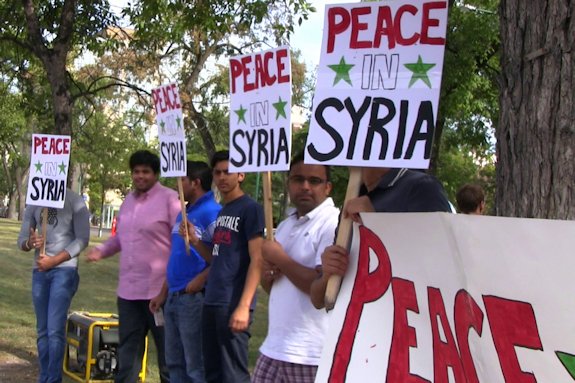
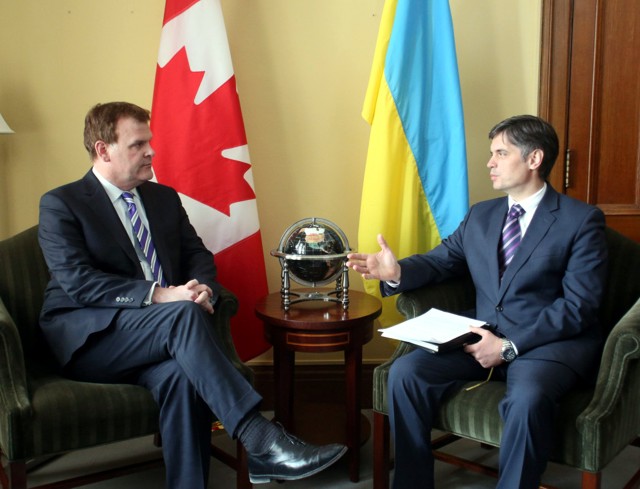
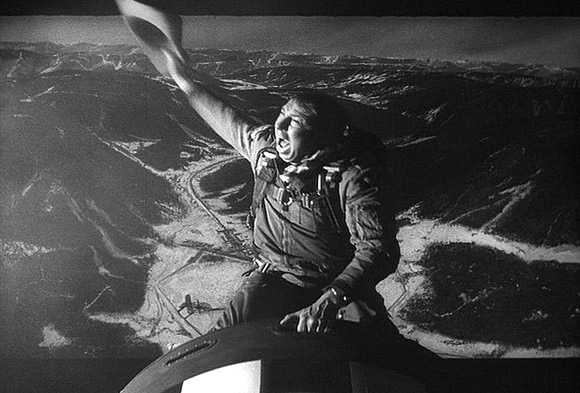

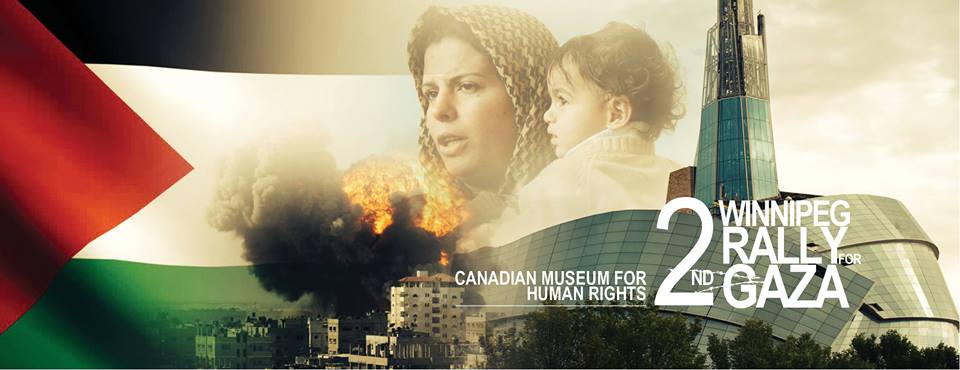

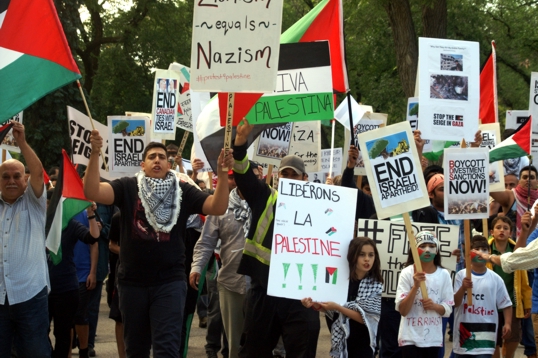
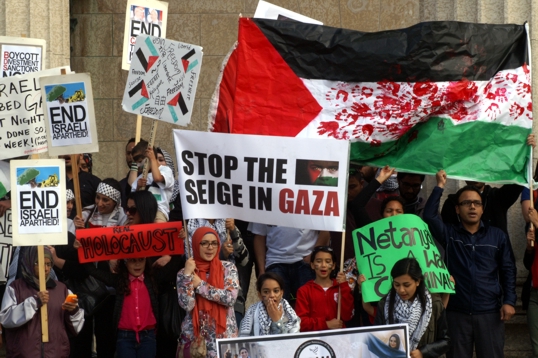


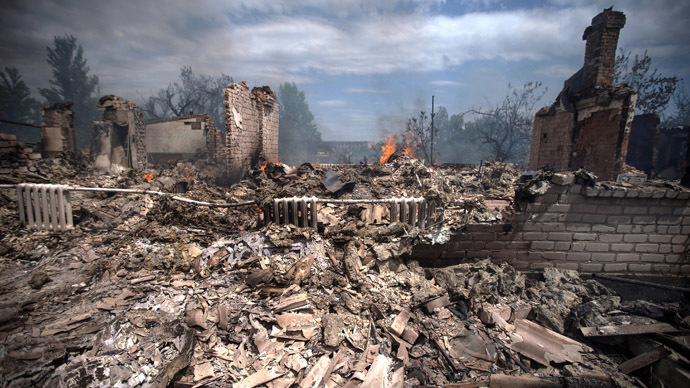
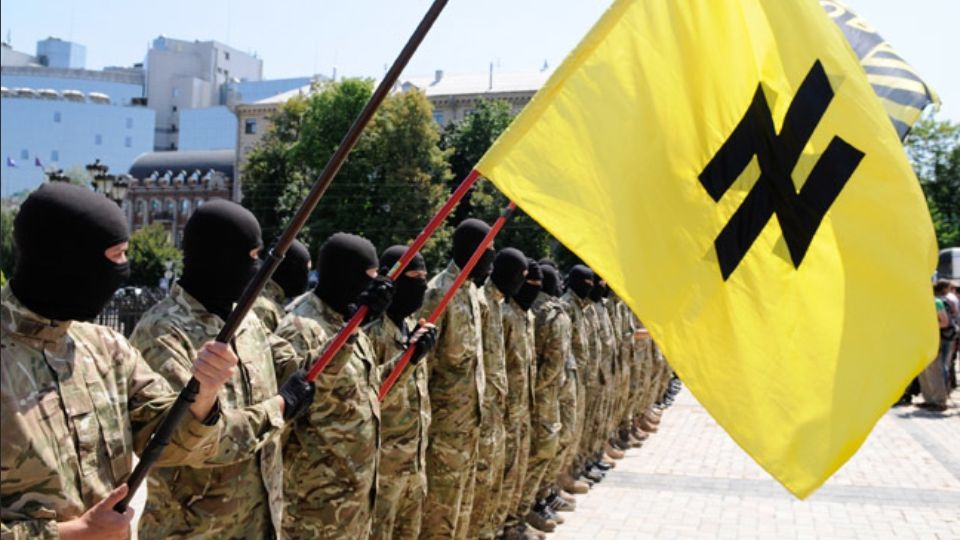
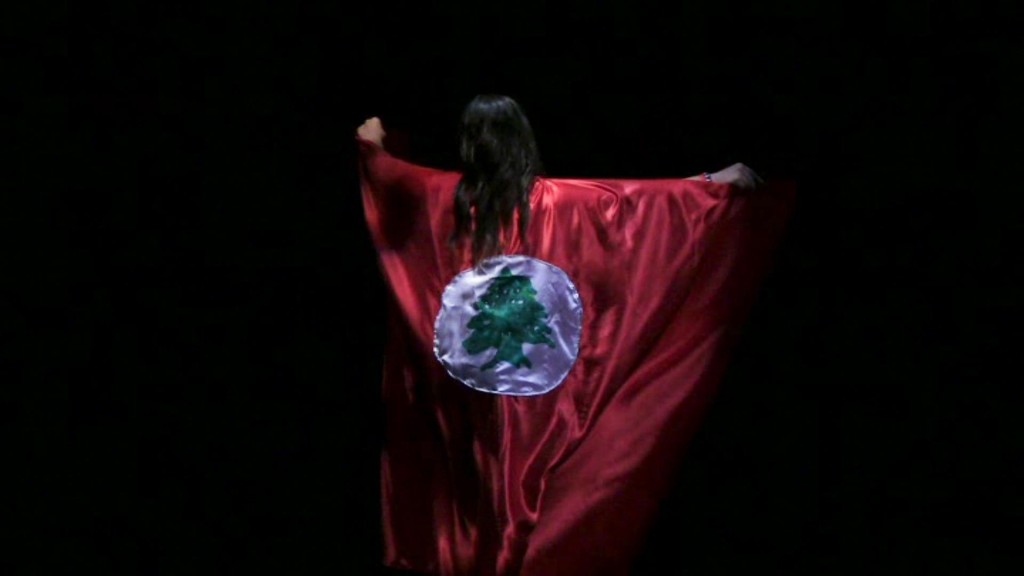
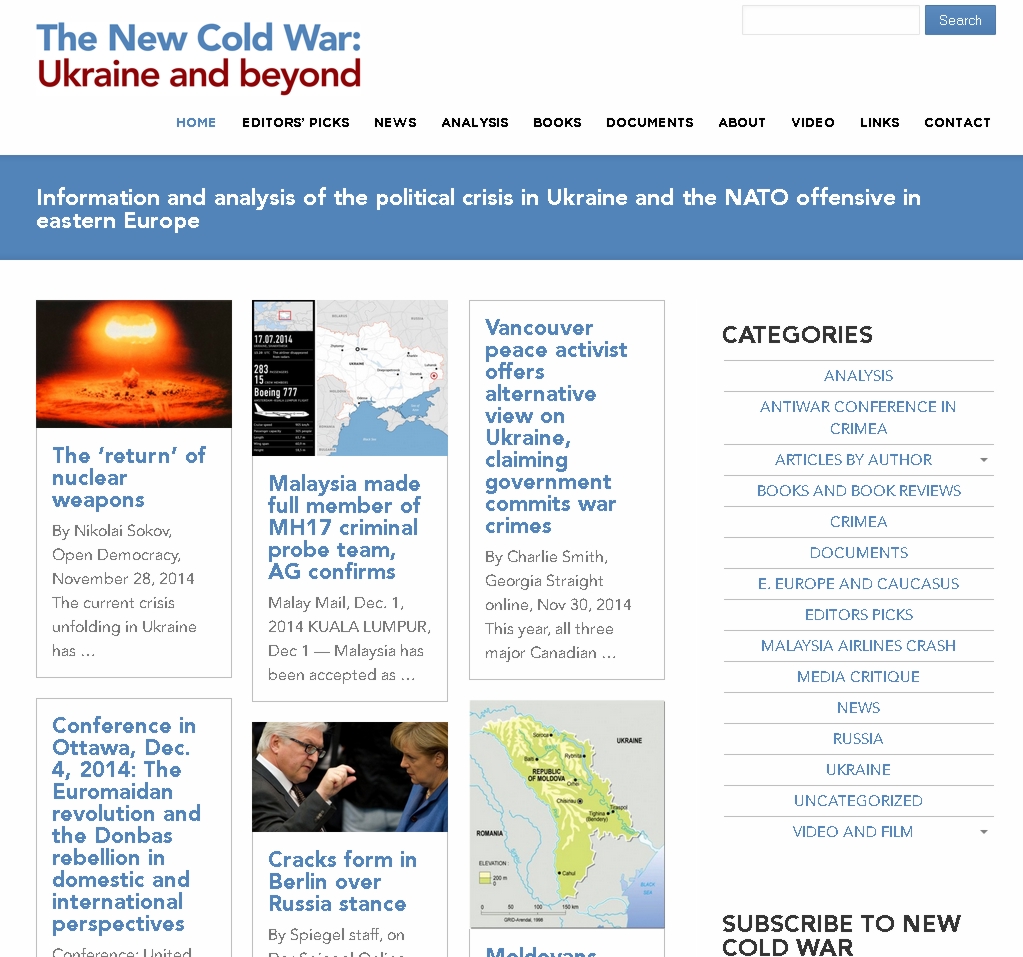
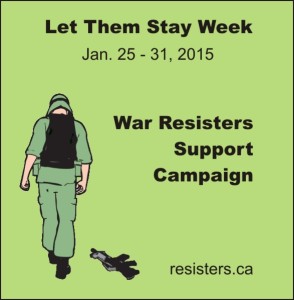
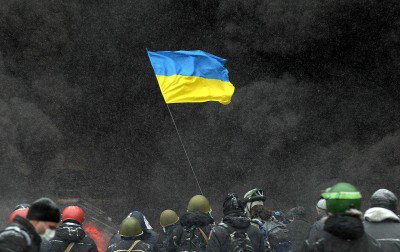
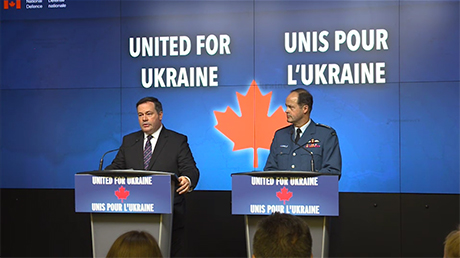
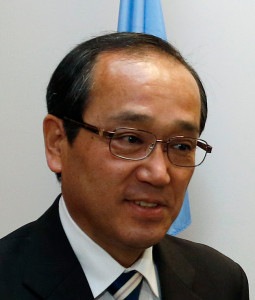


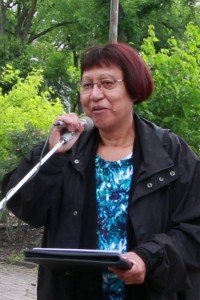
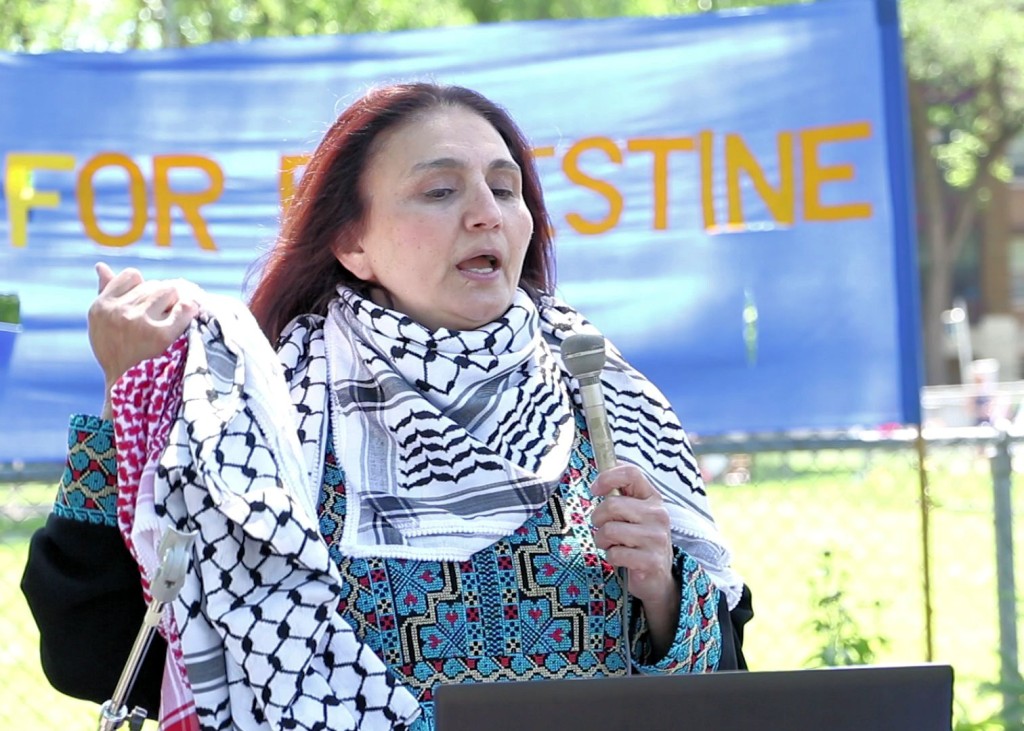
 In late 2000, the keffiyeh became political when the fashion world collided with the political world. All of a sudden, the traditional Arabic head dress became a fashion statement. In 2007, it even made it to the major couture houses including Balenciaga and stores across the US including Urban Outfitters began selling the keffiyeh as a fashion symbol scarf.
In late 2000, the keffiyeh became political when the fashion world collided with the political world. All of a sudden, the traditional Arabic head dress became a fashion statement. In 2007, it even made it to the major couture houses including Balenciaga and stores across the US including Urban Outfitters began selling the keffiyeh as a fashion symbol scarf. Dunkin Donuts
Dunkin Donuts Not much later, an Israeli scarf version of the keffiyeh appeared, much at the dismay of the Palestinians. Those who believe they understand the true symbolism of the keffiyeh have branded it as “anti-Semitic” and a “political statement supportive of Islamic terrorism against Israel.” Little do they know that the only democracy in the Middle East uses every means of psychological warfare as a weapon to disrupt history and culture, sadly not only affecting the world but the occupied Palestinians, too!
Not much later, an Israeli scarf version of the keffiyeh appeared, much at the dismay of the Palestinians. Those who believe they understand the true symbolism of the keffiyeh have branded it as “anti-Semitic” and a “political statement supportive of Islamic terrorism against Israel.” Little do they know that the only democracy in the Middle East uses every means of psychological warfare as a weapon to disrupt history and culture, sadly not only affecting the world but the occupied Palestinians, too! The black and white keffiyeh as we use it today is merely a traditional Arab head covering. Its importance to the cause came about when it became Yassir Arafat’s trademark. With his being the face of the PLO, the once meaningless head scarf meant to keep the sun out of the eyes and the dirt out of the face was given a meaning.
The black and white keffiyeh as we use it today is merely a traditional Arab head covering. Its importance to the cause came about when it became Yassir Arafat’s trademark. With his being the face of the PLO, the once meaningless head scarf meant to keep the sun out of the eyes and the dirt out of the face was given a meaning. Another Palestinian figure associated with the keffiyeh is Leila Khaled, a female member of the armed wing of the Popular Front for the Liberation of Palestine. Several photographs of Khaled circulated in the Western newspapers included Khaled wearing a keffiyeh in the style of a Muslim woman’s hijab, wrapped around the head and shoulders. This was unusual, as the keffiyeh is associated with Arab masculinity, and many believe this to be something of a fashion statement by Khaled, denoting her equality with men in the Palestinian armed struggle.
Another Palestinian figure associated with the keffiyeh is Leila Khaled, a female member of the armed wing of the Popular Front for the Liberation of Palestine. Several photographs of Khaled circulated in the Western newspapers included Khaled wearing a keffiyeh in the style of a Muslim woman’s hijab, wrapped around the head and shoulders. This was unusual, as the keffiyeh is associated with Arab masculinity, and many believe this to be something of a fashion statement by Khaled, denoting her equality with men in the Palestinian armed struggle.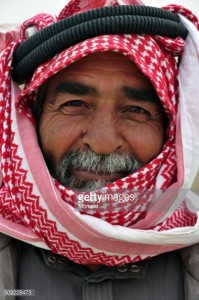
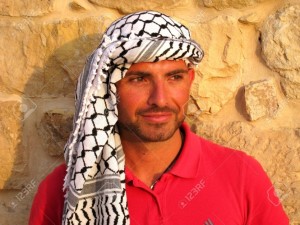 The colors of the stitching in a keffiyeh are also vaguely associated with Palestinians’ political sympathies. Traditional black and white keffiyehs became associated with Fatah. Later, red and white keffiyehs were adopted by Palestinian Marxists, such as the PFLP.
The colors of the stitching in a keffiyeh are also vaguely associated with Palestinians’ political sympathies. Traditional black and white keffiyehs became associated with Fatah. Later, red and white keffiyehs were adopted by Palestinian Marxists, such as the PFLP. For 50 years, Herbawi had been the only keffiyehs manufacturer, using 100% cotton. Today, this symbol of Palestinian identity is now largely imported from China. Herbawi Factory has 16 machines. In 1990, all 16 machines were functioning, making 750 keffiyehs per day. By 2010, only 2 machines were used, making a mere 300 keffiyehs per week.
For 50 years, Herbawi had been the only keffiyehs manufacturer, using 100% cotton. Today, this symbol of Palestinian identity is now largely imported from China. Herbawi Factory has 16 machines. In 1990, all 16 machines were functioning, making 750 keffiyehs per day. By 2010, only 2 machines were used, making a mere 300 keffiyehs per week.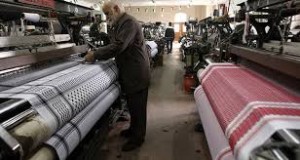 When the keffiyeh transformed to a fashion statement, ironically Chinese manufacturers instead of Palestinians profited from its sales. Although it is a bit clear that the Western world took the keffiyeh from Palestinian culture, the Israeli appropriation of the keffiyeh is more complicated.
When the keffiyeh transformed to a fashion statement, ironically Chinese manufacturers instead of Palestinians profited from its sales. Although it is a bit clear that the Western world took the keffiyeh from Palestinian culture, the Israeli appropriation of the keffiyeh is more complicated.